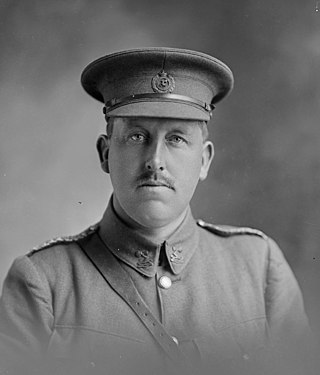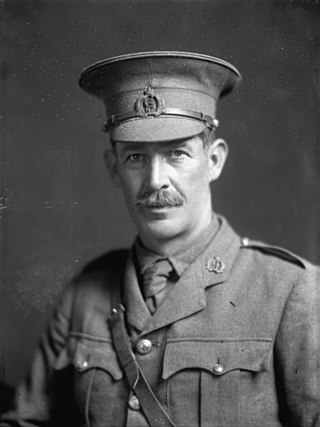
The Gallipoli campaign, the Dardanelles campaign, the Defence of Gallipoli or the Battle of Gallipoli was a military campaign in the First World War on the Gallipoli peninsula from 19 February 1915 to 9 January 1916. The Entente powers, Britain, France and the Russian Empire, sought to weaken the Ottoman Empire, one of the Central Powers, by taking control of the Ottoman straits. This would expose the Ottoman capital at Constantinople to bombardment by Entente battleships and cut it off from the Asian part of the empire. With the Ottoman Empire defeated, the Suez Canal would be safe and the Bosphorus and Dardanelles straits would be open to Entente supplies to the Black Sea and warm-water ports in Russia.

The New Zealand and Australian Division was a composite army division raised for service in the First World War under the command of Major General Alexander Godley. Consisting of several mounted and standard infantry brigades from both New Zealand and Australia, it served in the Gallipoli Campaign between April and December 1915.

The Battle of Hill 60 was one of the last major assault of the Gallipoli Campaign. It was launched on 21 August 1915 to coincide with the attack on Scimitar Hill made from the Suvla front by Major-General H. de B. De Lisle's British IX Corps, Frederick Stopford having been replaced in the few days previous. Hill 60 was a low knoll at the northern end of the Sari Bair range which dominated the Suvla landing. Capturing this hill along with Scimitar Hill would have allowed the Anzac and Suvla landings to be securely linked.

The Battle of Chunuk Bair was a World War I battle fought between the Ottoman defenders and troops of the British Empire over control of the peak in August 1915. The capture of Chunuk Bair,, the secondary peak of the Sari Bair range, was one of the two objectives of the Battle of Sari Bair.

The New Zealand Division was an infantry division of the New Zealand Expeditionary Force raised for service in the First World War. It was formed in Egypt in early 1916 when the New Zealand and Australian Division was renamed after the detachment of its Australian personnel left the New Zealand Infantry Brigade, together with reinforcements from New Zealand, as the basis of the division. It was commanded by Major General Andrew Hamilton Russell for the duration of the war.

The New Zealand Expeditionary Force (NZEF) was the title of the military forces sent from New Zealand to fight alongside other British Empire and Dominion troops during World War I (1914–1918) and World War II (1939–1945). Ultimately, the NZEF of World War I became known as the First New Zealand Expeditionary Force. The NZEF of World War II was known as the Second New Zealand Expeditionary Force (2NZEF).

The Australian and New Zealand Army Corps (ANZAC) was originally a First World War army corps of the Mediterranean Expeditionary Force. It was formed in Egypt in December 1914, and operated during the Gallipoli campaign. General William Birdwood commanded the corps, which primarily consisted of troops from the First Australian Imperial Force and 1st New Zealand Expeditionary Force, although there were also British and Indian units attached at times throughout the campaign. The corps disbanded in 1916, following the Allied evacuation of the Gallipoli peninsula and the formation of I ANZAC Corps and II ANZAC Corps. The corps was re-established, briefly, in the Second World War during the Battle of Greece in 1941. The term 'ANZAC' has been used since for joint Australian–New Zealand units of different sizes.
Lieutenant Colonel William George Malone was an officer in the New Zealand Expeditionary Force who served in the First World War. He commanded the Wellington Infantry Battalion during the Gallipoli Campaign, and was killed in action by friendly fire during the Battle of Chunuk Bair.

Lieutenant Colonel Arthur Plugge, CMG, was an English-born officer who served during the First World War with the New Zealand Military Forces.

The military history of New Zealand during World War I began in August 1914. When Britain declared war on Germany at the start of the First World War, the New Zealand Government followed without hesitation, despite its geographic isolation and small population. It was believed at the time that any declaration of war by the United Kingdom automatically included New Zealand; and the Governor announced that New Zealand was at war with Germany from the steps of Parliament on 5 August.

Major General Sir Andrew Hamilton Russell was a senior officer of the New Zealand Military Forces who served during the First World War.

Brigadier-General Francis Earl Johnston, was a New Zealand-born British Army officer of the First World War, who served in the New Zealand Expeditionary Force (NZEF) at Gallipoli and on the Western Front.

The New Zealand Pioneer Battalion (NZPB), later known as the New Zealand (Māori) Pioneer Battalion or New Zealand Māori (Pioneer) Battalion, was a battalion of the New Zealand Expeditionary Force (NZEF) that served during the Great War. The battalion was formed in Egypt in March 1916 upon New Zealand Divisional Orders of 20 February, and drawn from surplus officers and other ranks of the New Zealand Mounted Rifles (NZMR), the Otago Mounted Rifles (OMR) and the New Zealand Native Contingent (NZNC) then serving in Egypt with the New Zealand Infantry Brigade. It consisted of Māori, Pākehā and Pacific Islanders. "By the end of the war, 2227 Maori and 458 Pacific Islanders had served in what became known as the Maori Pioneer Battalion. Of these, 336 died on active service and 734 were wounded. Other Maori enlisted in other units."

The 1st Brigade is currently the largest unit of the New Zealand Army, and contains most of the army's deployable units. The brigade was formed on 13 December 2011 by amalgamating the 2nd Land Force Group and 3rd Land Force Group. Its establishment formed part of the 'Army 2015' package of reforms.

Brigadier General William Meldrum was a New Zealand lawyer, farmer, military leader, magistrate and local politician.

Lieutenant-Colonel George Augustus King was a New Zealander who served in the New Zealand Military Forces during the First World War.
John Gethin Hughes was a New Zealand military leader. Born in Bluff, Southland, New Zealand, he served in the Boer War with the First Contingent of the New Zealand Volunteer Force to be sent to South Africa. During the war he was the first New Zealand recipient of the Distinguished Service Order. After the war he became a professional soldier and served in a number of staff positions in the New Zealand Military Forces. A member of the New Zealand Expeditionary Force during the early stages of the First World War, he commanded the Canterbury Battalion during the Gallipoli campaign. He was eventually evacuated from Gallipoli late in the campaign for medical reasons. He retired from the military in 1917 due to poor health and died in 1954 at the age of 88.
John Braithwaite was a New Zealander who served in the First World War with the New Zealand Expeditionary Force. Supposedly a journalist before the war, in 1916 he was convicted of mutiny and executed by firing squad. He was posthumously pardoned in September 2000 through the passage of the Pardon for Soldiers of the Great War Act 2000.

Brigadier-General Charles Henry Jeffries Brown DSO was a New Zealand Military Forces officer who served in the First World War, firstly in the Gallipoli campaign and then on the Western Front. He was commander of the 1st Infantry Brigade from February 1917 until he was killed by artillery fire on 8 June 1917, one of three New Zealand brigadier generals who died during the war.

Arthur Bauchop, was an officer in the New Zealand Military Forces who served in the Second Boer War and the First World War. He commanded the Otago Mounted Rifles during the Gallipoli campaign, and died of wounds received during the Battle of Chunuk Bair.


















